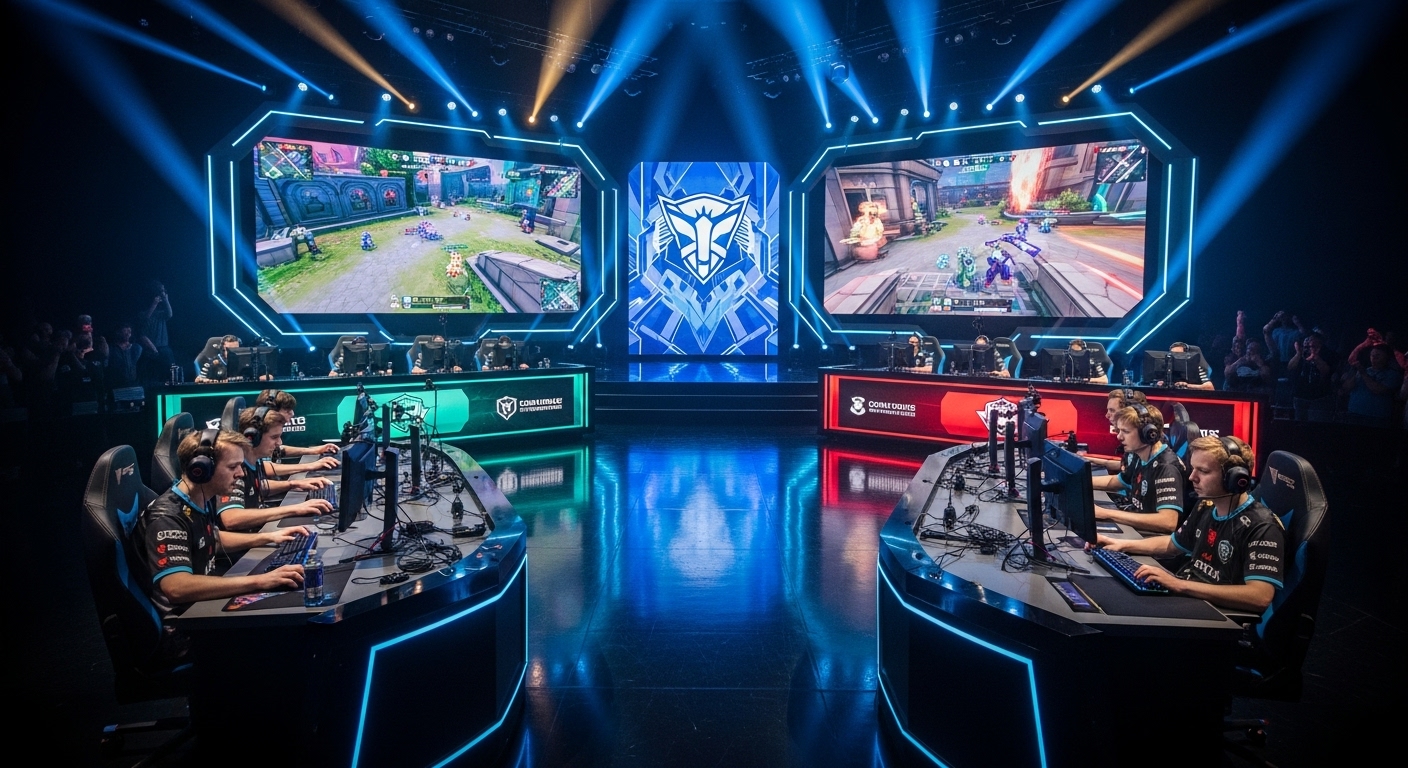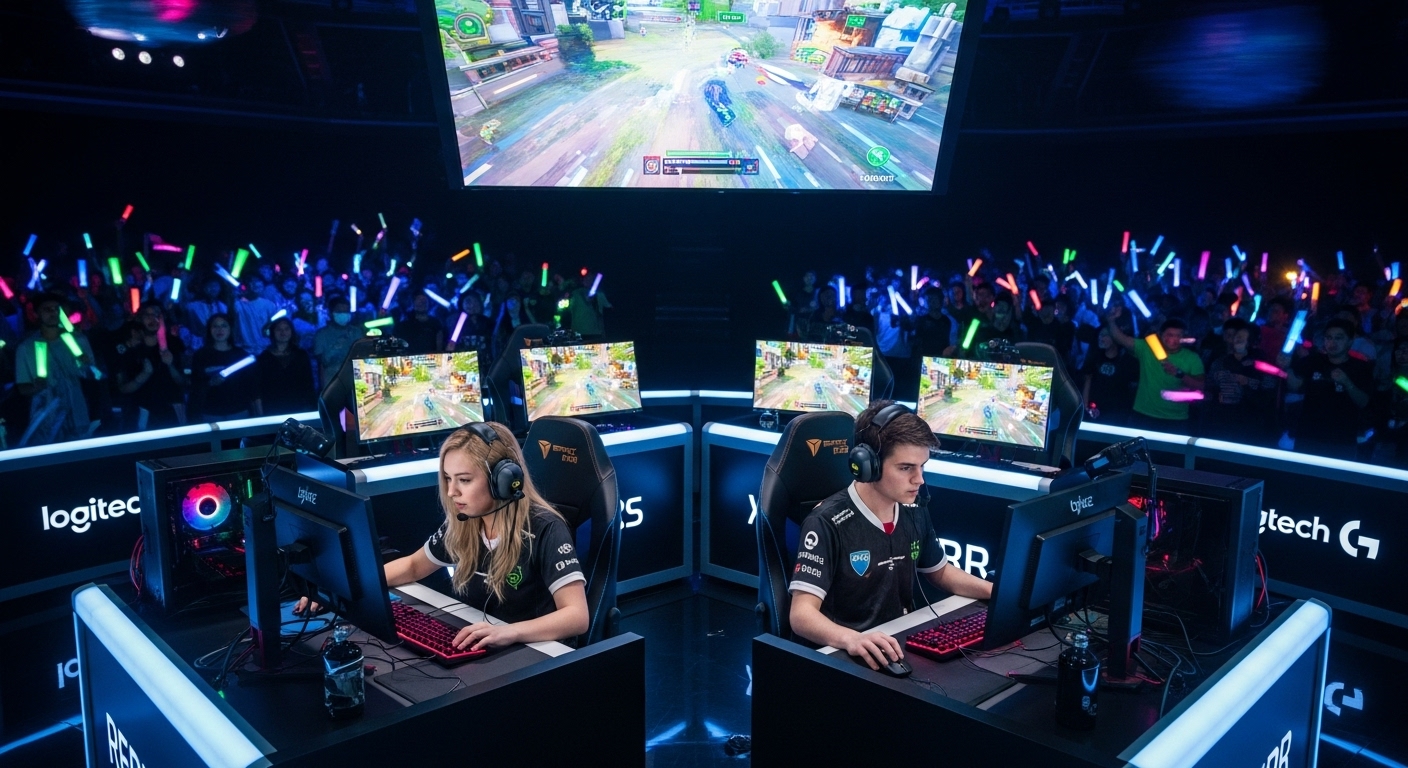Introduction
Once seen as a simple pastime for teenagers, video games have grown into one of the largest entertainment industries in the world. And at the center of this evolution stands Esports—competitive gaming on a professional level. What began as small local tournaments has turned into multi-million-dollar global competitions watched by millions of fans.
This transformation didn’t happen overnight. It took decades of technological advancement, community passion, and industry innovation to bring Esports where it is today. From basement LAN parties to sold-out arenas, Esports has rewritten what competition looks like in the digital age.
This post dives deep into the fascinating journey of Esports—its origins, growth, cultural impact, challenges, and the promising future ahead.
The Origins of Esports
The Early Days of Competitive Gaming
Competitive gaming can be traced back to the 1970s. The very first known gaming tournament took place in 1972 at Stanford University. The game was Spacewar!, and the prize was a year’s subscription to Rolling Stone magazine. It might seem small compared to today’s million-dollar prize pools, but this was the humble beginning of a massive global movement.
Through the 1980s, video games became increasingly popular with the rise of arcades. Games like Pac-Man, Donkey Kong, and Street Fighter introduced high-score competitions. Players battled to have their names appear at the top of the leaderboard, gaining local fame and bragging rights.
While there wasn’t yet an organized Esports structure, these early competitions planted the seeds for what was to come.
The Internet Era and LAN Tournaments
The 1990s brought something revolutionary—home internet connections and personal computers capable of running advanced games. This changed everything.
LAN (Local Area Network) parties became the heart of early competitive gaming. Players gathered with bulky monitors and desktop towers to connect and compete. Titles like Doom, Quake, and StarCraft became staples of these gatherings.
The creation of professional gaming leagues began around this time. The Cyberathlete Professional League (CPL), founded in 1997, is often credited as the first major organized Esports league. It gave gamers a platform to compete professionally and proved that gaming could be more than a hobby.
The 2000s: The Foundation of Modern Esports
StarCraft and the South Korean Influence
If there’s one country that truly kickstarted Esports as a professional industry, it’s South Korea. After the Asian financial crisis in the late 1990s, the government invested heavily in internet infrastructure. This led to an explosion of PC bangs—gaming cafes—across the country.
StarCraft: Brood War became the centerpiece of Korean gaming culture. Professional players were treated like celebrities, televised matches drew millions of viewers, and sponsorships poured in. The Korean Esports Association (KeSPA) was established in 2000, formalizing the structure and management of Esports in the country.
South Korea proved that gaming could be a spectator sport—and the rest of the world began to take notice.
Western Growth and the Role of Consoles
Meanwhile, in North America and Europe, competitive gaming began expanding through console titles. Halo, Call of Duty, and Counter-Strike developed loyal competitive scenes. Organizations like Major League Gaming (MLG), founded in 2002, started hosting large-scale tournaments with live audiences and broadcasting coverage.
MLG was one of the first to treat Esports like traditional sports, using professional commentators, structured brackets, and sponsorship deals. This laid the groundwork for how global tournaments operate today.
The Explosion of Esports in the 2010s
The Streaming Revolution
No development was more influential for Esports than the rise of streaming platforms. In 2011, a platform called Twitch launched and changed everything. Suddenly, anyone could watch professional gamers play in real-time from anywhere in the world.
Twitch gave fans direct access to players, fostering communities around specific games and personalities. Viewership numbers skyrocketed, and Esports became mainstream entertainment.
Games like League of Legends, Dota 2, and Counter-Strike: Global Offensive led this new era. Each title had a thriving professional scene, global tournaments, and millions of fans tuning in regularly.
League of Legends and Global Esports
Riot Games’ League of Legends (LoL) deserves special mention. The game’s developer didn’t just create a hit title—they built an entire ecosystem around it. Regional leagues, a yearly world championship, and professional contracts for players turned LoL into the cornerstone of modern Esports.
By 2018, the League of Legends World Championship finals drew over 100 million viewers—on par with major sporting events like the Super Bowl.
This kind of global engagement demonstrated the immense cultural power of Esports.
The Rise of Multi-Game Ecosystems
While LoL and Dota 2 dominated the MOBA (Multiplayer Online Battle Arena) scene, other genres also thrived. Overwatch, Fortnite, PUBG, and Valorant brought diverse audiences into Esports.
Battle royale titles introduced a new level of unpredictability and excitement. Fortnite, for instance, blurred the line between gaming, entertainment, and celebrity culture with its massive crossover events and charismatic young stars.
The result was a booming global market worth billions of dollars and a fanbase that spanned generations.
The Structure of Modern Esports
Teams, Players, and Organizations
Today’s Esports ecosystem mirrors traditional sports in many ways. Teams operate as professional organizations with coaches, analysts, and managers. Players sign contracts, train full-time, and earn salaries in addition to tournament winnings.
Top players—like Faker from League of Legends or s1mple from Counter-Strike—are household names among fans. They attract sponsorships, brand deals, and millions of social media followers.
Teams such as Team Liquid, Fnatic, T1, and Cloud9 are not just gaming groups—they’re international brands with massive fanbases.
Sponsorships and Revenue Streams
Money in Esports comes from several key sources: sponsorships, advertising, media rights, merchandise, and ticket sales. Global corporations like Intel, Red Bull, and Coca-Cola invest heavily in Esports events.
Tournament organizers also make revenue through partnerships with streaming platforms and broadcasters. Prize pools continue to grow yearly—Valve’s The International tournament for Dota 2 has offered prizes exceeding $40 million.
These financial structures prove that Esports isn’t just a trend—it’s a stable, profitable industry.
The Cultural Impact of Esports
Changing Perceptions of Gaming
For decades, gaming was dismissed as unproductive or childish. Esports has completely flipped that narrative. It’s now recognized as a legitimate form of competition, demanding strategy, teamwork, and mental discipline.
In many countries, professional gamers are considered athletes. Universities offer Esports scholarships, and governments are beginning to support competitive gaming programs.
The psychological and physical preparation behind high-level play—reaction time, coordination, focus, and stress management—mirror the training of traditional sports professionals.
The Power of Community
Esports thrives on community. Fans don’t just watch—they engage. Online forums, fan art, cosplay, and social media discussions keep the culture alive between tournaments.
This engagement has also made Esports one of the most inclusive forms of entertainment. Players and fans come from every part of the world, connected by a shared love for gaming. Language barriers fade when excitement takes over during a live match.
Influence on Pop Culture
The impact of Esports extends beyond gaming. Mainstream media, music, and fashion have all embraced it. Artists perform at gaming events, luxury brands sponsor teams, and Hollywood studios adapt game stories into films and shows.
What was once niche is now a cornerstone of modern culture.
Challenges Facing the Esports Industry
Player Burnout and Mental Health
Behind the glamour lies a demanding lifestyle. Professional gamers often train for 8–12 hours a day, balancing scrimmages, strategy sessions, and content creation.
This intense schedule, combined with the pressure to perform, leads to burnout and mental health issues. Many players retire young—often before the age of 25—because of physical or emotional strain.
Organizations are starting to prioritize player welfare with counseling services and balanced training schedules, but there’s still a long way to go.
Competitive Integrity
Cheating, match-fixing, and doping scandals occasionally taint the industry’s image. Since Esports operates across multiple regions and titles, maintaining fair play is complex.
Developers, tournament organizers, and Esports federations are working to enforce stricter regulations, but global standardization remains a challenge.
Sustainability and Market Saturation
The rapid growth of Esports also creates instability. New games enter the scene every year, and not all survive. Some titles lose their player base or fail to maintain viewership, leading to league collapses or team disbandments.
Balancing innovation with stability is one of the biggest challenges facing the industry’s long-term sustainability.
The Role of Technology in Esports
Advancements in Hardware and Connectivity
The progress of gaming technology directly fuels Esports’ success. Modern gaming PCs, high-refresh-rate monitors, and ultra-fast internet connections enable smoother, more competitive gameplay.
The rise of 5G and fiber optics has made online tournaments nearly lag-free, connecting players from opposite sides of the planet in real time.
Virtual reality (VR) and augmented reality (AR) are also being explored as potential future platforms for competitive gaming.
Data Analytics and AI Integration
Data analytics has become a powerful tool in Esports. Teams analyze player statistics, movement patterns, and in-game decisions to gain a competitive edge.
Artificial intelligence is also entering the scene. AI coaches can review matches, predict outcomes, and provide insights that were once impossible for humans to calculate.
This integration of technology ensures that Esports remains one of the most advanced competitive ecosystems in existence.
Esports and Education
Academic Recognition
Educational institutions have begun acknowledging Esports as a legitimate academic pursuit. Universities in the United States, the United Kingdom, and Asia offer scholarships for skilled players. Some schools have even built dedicated Esports arenas for training and competition.
Courses in game design, Esports management, and digital marketing prepare students for careers in this growing field.
It’s not just about playing—Esports also teaches teamwork, leadership, problem-solving, and communication skills that translate well into many professions.
Youth Engagement and Opportunities
Esports provides young people with an alternative avenue for achievement. Instead of traditional sports or arts, gaming gives talented individuals a way to express skill and dedication.
The industry also creates thousands of jobs beyond players—casters, event organizers, software developers, and analysts all contribute to the Esports ecosystem.
The Global Reach of Esports
Regional Powerhouses
Different regions have different strengths in Esports. South Korea remains dominant in strategy and MOBA titles. Europe has produced elite talent in games like CS:GO and FIFA. North America excels in shooter and battle royale games, while China boasts some of the largest audiences and highest investment levels.
This global balance ensures that Esports never feels monopolized—every region brings its own culture and flavor to the scene.
The Role of Global Events
Tournaments like The International, Fortnite World Cup, and League of Legends Worlds bring together fans from every corner of the planet.
These events often rival the Olympics or the World Cup in scale and excitement. The energy in a packed Esports arena—cheering fans, flashing lights, and breathtaking plays—is something few other entertainment forms can replicate.
The Future of Esports
Mainstream Integration
The line between Esports and traditional sports continues to blur. Established sports franchises like the NBA and Formula 1 now have Esports divisions.
Television networks broadcast tournaments alongside regular sporting events. This integration suggests that Esports will soon become a permanent fixture in mainstream entertainment, not just a subculture.
Emerging Technologies and the Metaverse
The next chapter of Esports may unfold in the metaverse—a fully immersive digital world where players and fans interact seamlessly.
Virtual stadiums, personalized avatars, and real-time fan participation could redefine how competitions are experienced. Technologies like blockchain may also enable transparent prize distribution and ownership of digital assets.
Continued Growth and Professionalization
With each passing year, Esports grows more structured and professional. Regulatory bodies are emerging, health standards are improving, and investment continues to pour in.
As younger generations who grew up gaming enter adulthood, the audience base will only expand further.
Conclusion
From a handful of college students playing Spacewar! in the 1970s to millions of global fans filling stadiums and watching online streams, the story of Esports is nothing short of extraordinary.
It’s a testament to human creativity, connection, and competition. What makes Esports special isn’t just the games—it’s the community, the innovation, and the spirit of play that unites people across borders.
The journey is far from over. Esports continues to evolve, adapt, and inspire. It represents the future of entertainment—a digital arena where skill, strategy, and passion collide.



